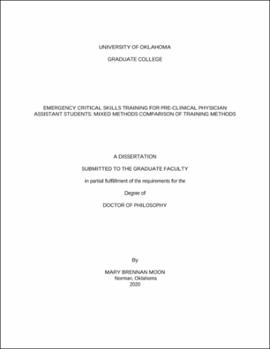| dc.description.abstract | Importance: PAs enter the medical field, on average, 27 months after beginning their program. Due to the fast-paced nature of PA programs, an emphasis on high-fidelity, critical care skill training is warranted. PA programs’ procedural skills training is variable, and faculty commonly use inanimate objects, such as manikins or task-trainers, to assess student performance. Lightly fixed cadavers provide a high-fidelity training model to teach high-acuity, low-opportunity procedures. Currently, the effectiveness of lightly fixed cadavers compared to task trainers to teach invasive, emergent clinical skills to PA students has not been thoroughly evaluated.
Objectives: 1) Compare performance of video, task trainer, and soft-fixed cadaver trained PA students in completing chest tube insertion, intubation, intraosseous insertion, and needle chest decompression, to establish evidenced-based training methods for emergency procedural skill acquisition among PA students. 2) Explore student perspectives regarding training methods and perceptions of preparedness.
Methods: Forty-eight pre-clinical PAs participated in clinical skills training on chest tube insertion, endotracheal intubation, intraosseous insertion, and needle decompression in one of the following training groups: video, cadaver, or task trainer. Randomized, stratified sampling was utilized to ensure students with differing medical experience had equal representation across training groups. Following training, student performance was assessed using skill specific rubrics. Students perceptions of preparedness to perform each skill in a clinical setting was examined pre and post intervention.
Results: All three training groups had significantly different scores in comparing chest tube insertion, intubation, intraosseous insertion, and needle decompression (p=0.046, p=0.0009, p=0.0019, and p<0.0001 respectively). Cadaver-trained students scored significantly higher than task trainer-trained students in intubation (p=0.0003) and intraosseous insertion (p=0.0012).
Conclusion: Lightly fixed cadaver training can provide significantly higher pre-clinical PA student performance of endotracheal intubation and intraosseous insertion in comparison to task trainers or video training. Video-trained students performed significantly worse than their hands-on trained counterparts. Student perspectives on preparedness can provide valuable insight into procedural skill training; however, perspectives were not indicative of assessment performance. | en_US |
